Human-Computer Interaction: User-Focused Design and Usability Analysis
VerifiedAdded on 2022/11/16
|8
|2057
|143
Report
AI Summary
This report provides an overview of Human-Computer Interaction (HCI), emphasizing the importance of user-centered design and usability principles. It begins with an introduction to HCI, defining its multidisciplinary nature and its focus on the design of computer technology and user interfaces. A literature review is then presented, analyzing previous research on the role of user-centered design and usability principles in software development. The review highlights the benefits of user-centered design, such as improved effectiveness and reduced errors, and discusses various techniques and principles for implementing effective user interfaces. The report examines the key factors of usability, including usefulness and simplicity, and concludes by summarizing the importance of adopting reliable approaches in developing human-computer interfaces to enhance software performance and user satisfaction. The report references multiple sources to support its analysis, offering insights into how to effectively design software based on user needs.
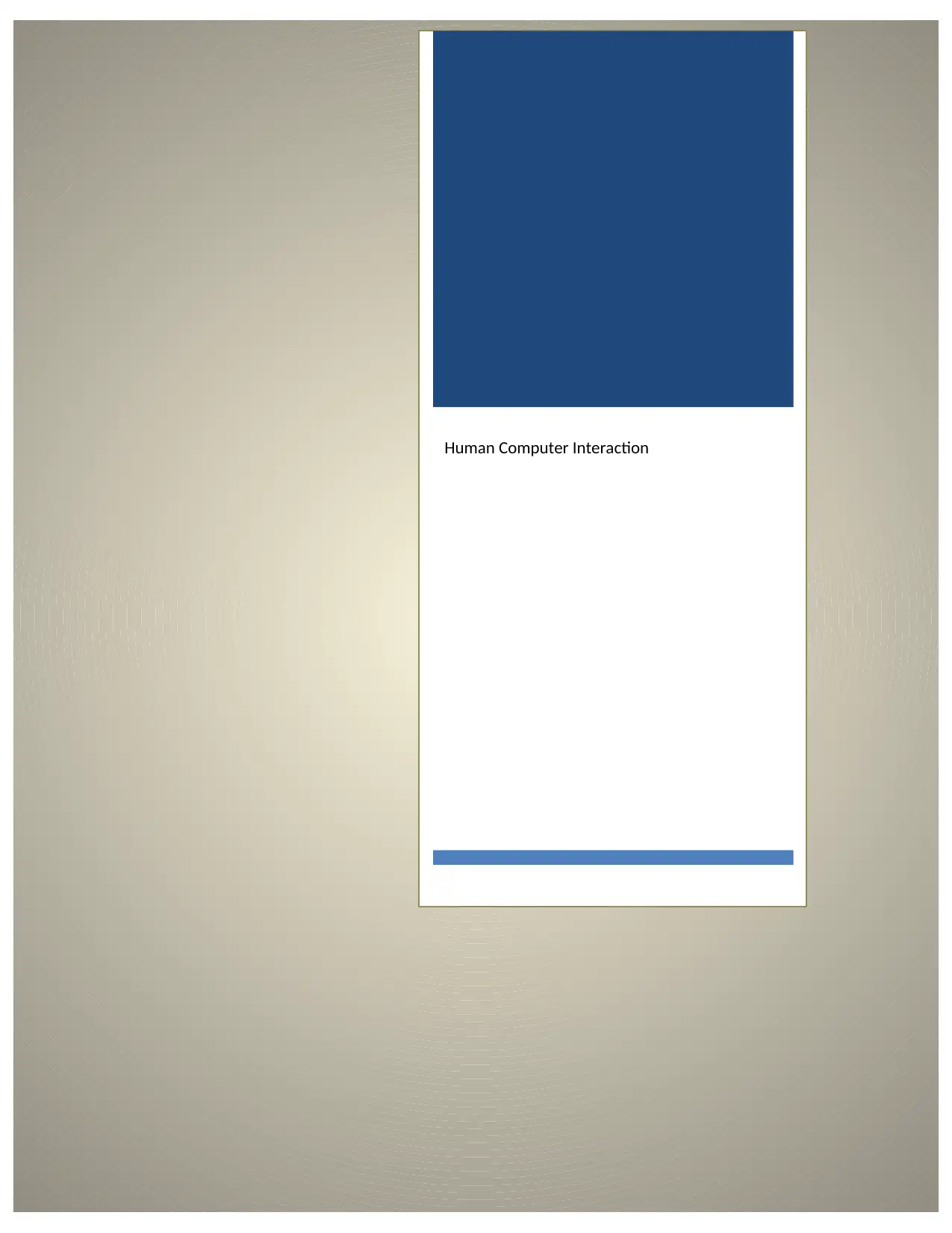
Human Computer Interaction
Paraphrase This Document
Need a fresh take? Get an instant paraphrase of this document with our AI Paraphraser
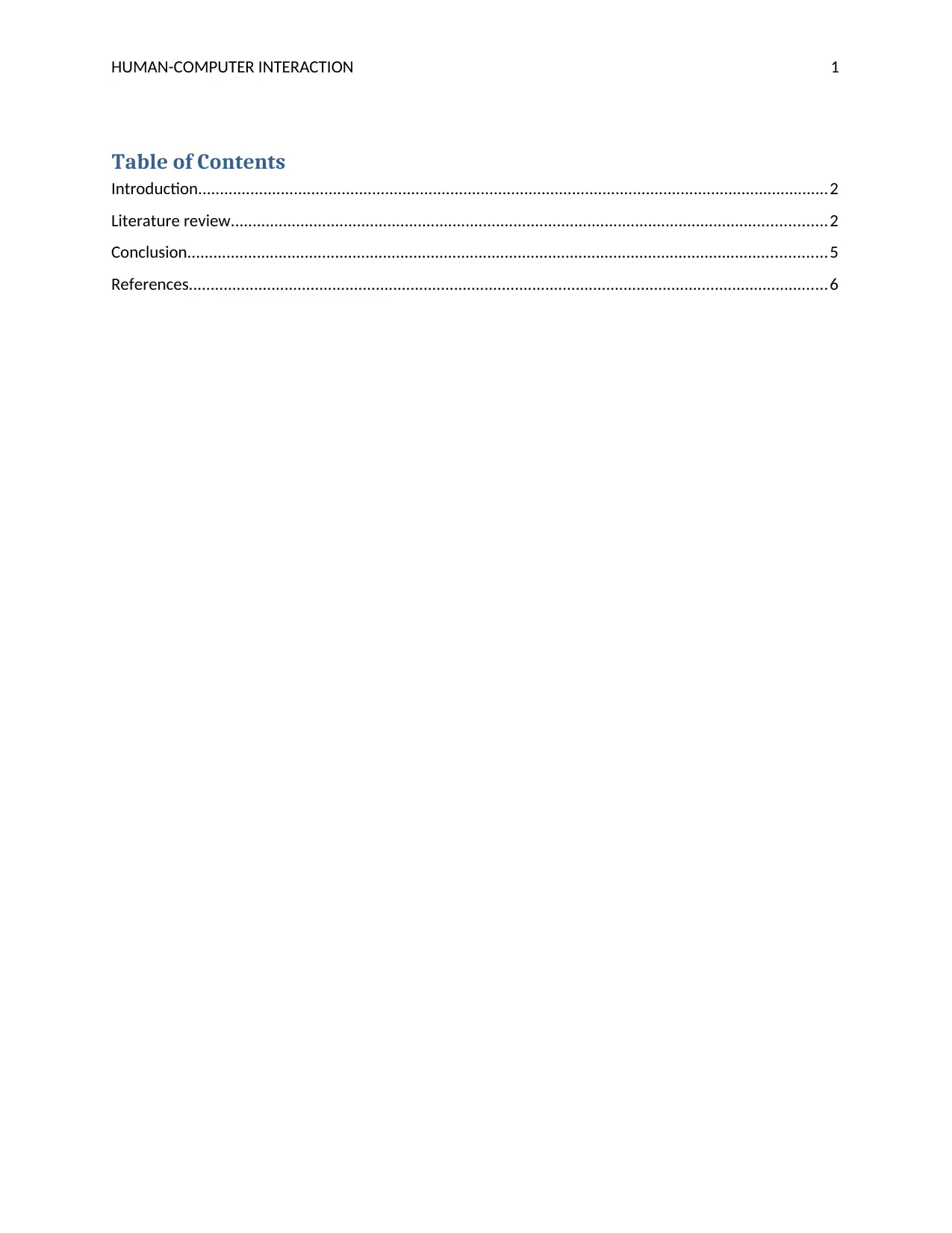
HUMAN-COMPUTER INTERACTION 1
Table of Contents
Introduction.................................................................................................................................................2
Literature review.........................................................................................................................................2
Conclusion...................................................................................................................................................5
References...................................................................................................................................................6
Table of Contents
Introduction.................................................................................................................................................2
Literature review.........................................................................................................................................2
Conclusion...................................................................................................................................................5
References...................................................................................................................................................6
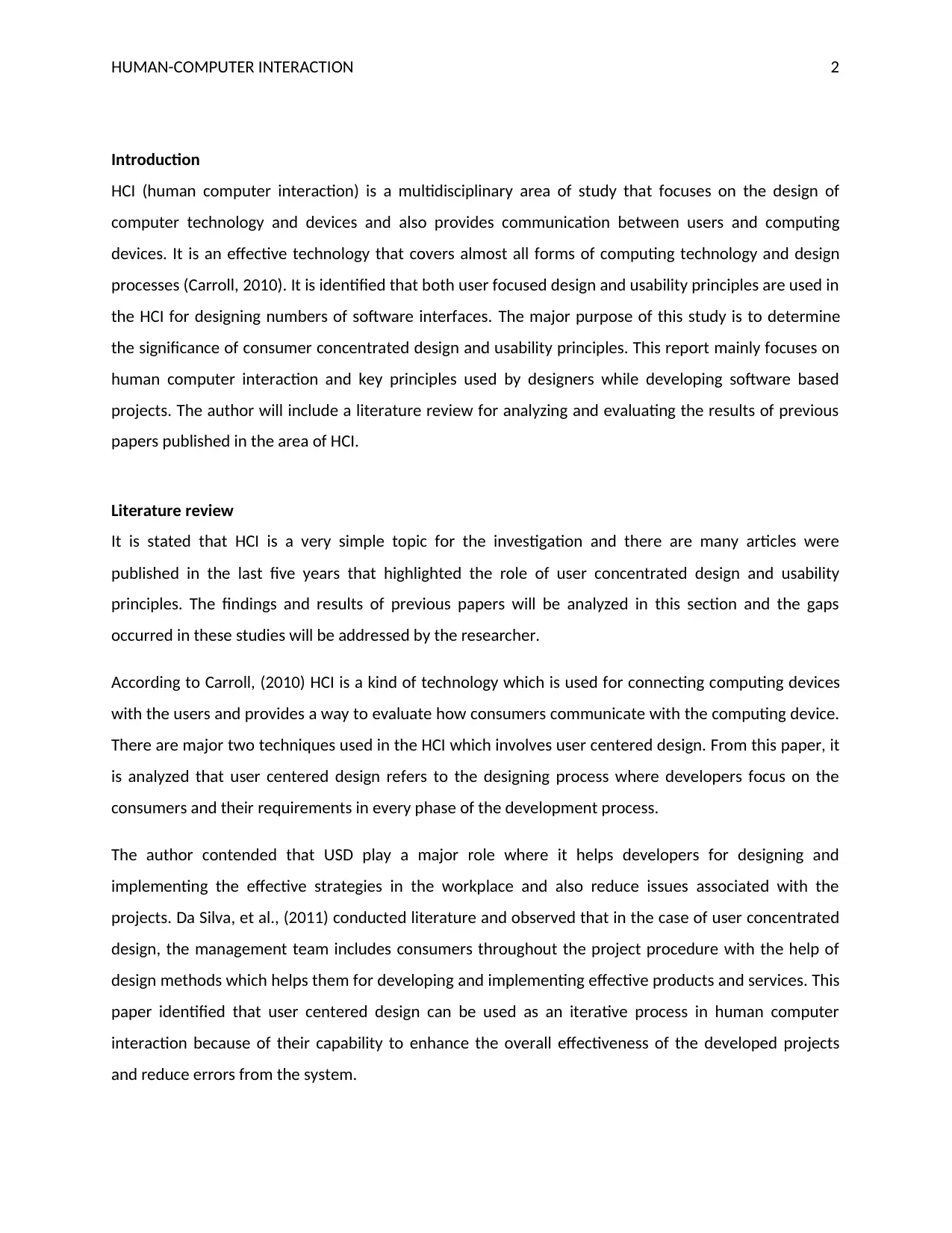
HUMAN-COMPUTER INTERACTION 2
Introduction
HCI (human computer interaction) is a multidisciplinary area of study that focuses on the design of
computer technology and devices and also provides communication between users and computing
devices. It is an effective technology that covers almost all forms of computing technology and design
processes (Carroll, 2010). It is identified that both user focused design and usability principles are used in
the HCI for designing numbers of software interfaces. The major purpose of this study is to determine
the significance of consumer concentrated design and usability principles. This report mainly focuses on
human computer interaction and key principles used by designers while developing software based
projects. The author will include a literature review for analyzing and evaluating the results of previous
papers published in the area of HCI.
Literature review
It is stated that HCI is a very simple topic for the investigation and there are many articles were
published in the last five years that highlighted the role of user concentrated design and usability
principles. The findings and results of previous papers will be analyzed in this section and the gaps
occurred in these studies will be addressed by the researcher.
According to Carroll, (2010) HCI is a kind of technology which is used for connecting computing devices
with the users and provides a way to evaluate how consumers communicate with the computing device.
There are major two techniques used in the HCI which involves user centered design. From this paper, it
is analyzed that user centered design refers to the designing process where developers focus on the
consumers and their requirements in every phase of the development process.
The author contended that USD play a major role where it helps developers for designing and
implementing the effective strategies in the workplace and also reduce issues associated with the
projects. Da Silva, et al., (2011) conducted literature and observed that in the case of user concentrated
design, the management team includes consumers throughout the project procedure with the help of
design methods which helps them for developing and implementing effective products and services. This
paper identified that user centered design can be used as an iterative process in human computer
interaction because of their capability to enhance the overall effectiveness of the developed projects
and reduce errors from the system.
Introduction
HCI (human computer interaction) is a multidisciplinary area of study that focuses on the design of
computer technology and devices and also provides communication between users and computing
devices. It is an effective technology that covers almost all forms of computing technology and design
processes (Carroll, 2010). It is identified that both user focused design and usability principles are used in
the HCI for designing numbers of software interfaces. The major purpose of this study is to determine
the significance of consumer concentrated design and usability principles. This report mainly focuses on
human computer interaction and key principles used by designers while developing software based
projects. The author will include a literature review for analyzing and evaluating the results of previous
papers published in the area of HCI.
Literature review
It is stated that HCI is a very simple topic for the investigation and there are many articles were
published in the last five years that highlighted the role of user concentrated design and usability
principles. The findings and results of previous papers will be analyzed in this section and the gaps
occurred in these studies will be addressed by the researcher.
According to Carroll, (2010) HCI is a kind of technology which is used for connecting computing devices
with the users and provides a way to evaluate how consumers communicate with the computing device.
There are major two techniques used in the HCI which involves user centered design. From this paper, it
is analyzed that user centered design refers to the designing process where developers focus on the
consumers and their requirements in every phase of the development process.
The author contended that USD play a major role where it helps developers for designing and
implementing the effective strategies in the workplace and also reduce issues associated with the
projects. Da Silva, et al., (2011) conducted literature and observed that in the case of user concentrated
design, the management team includes consumers throughout the project procedure with the help of
design methods which helps them for developing and implementing effective products and services. This
paper identified that user centered design can be used as an iterative process in human computer
interaction because of their capability to enhance the overall effectiveness of the developed projects
and reduce errors from the system.
⊘ This is a preview!⊘
Do you want full access?
Subscribe today to unlock all pages.

Trusted by 1+ million students worldwide
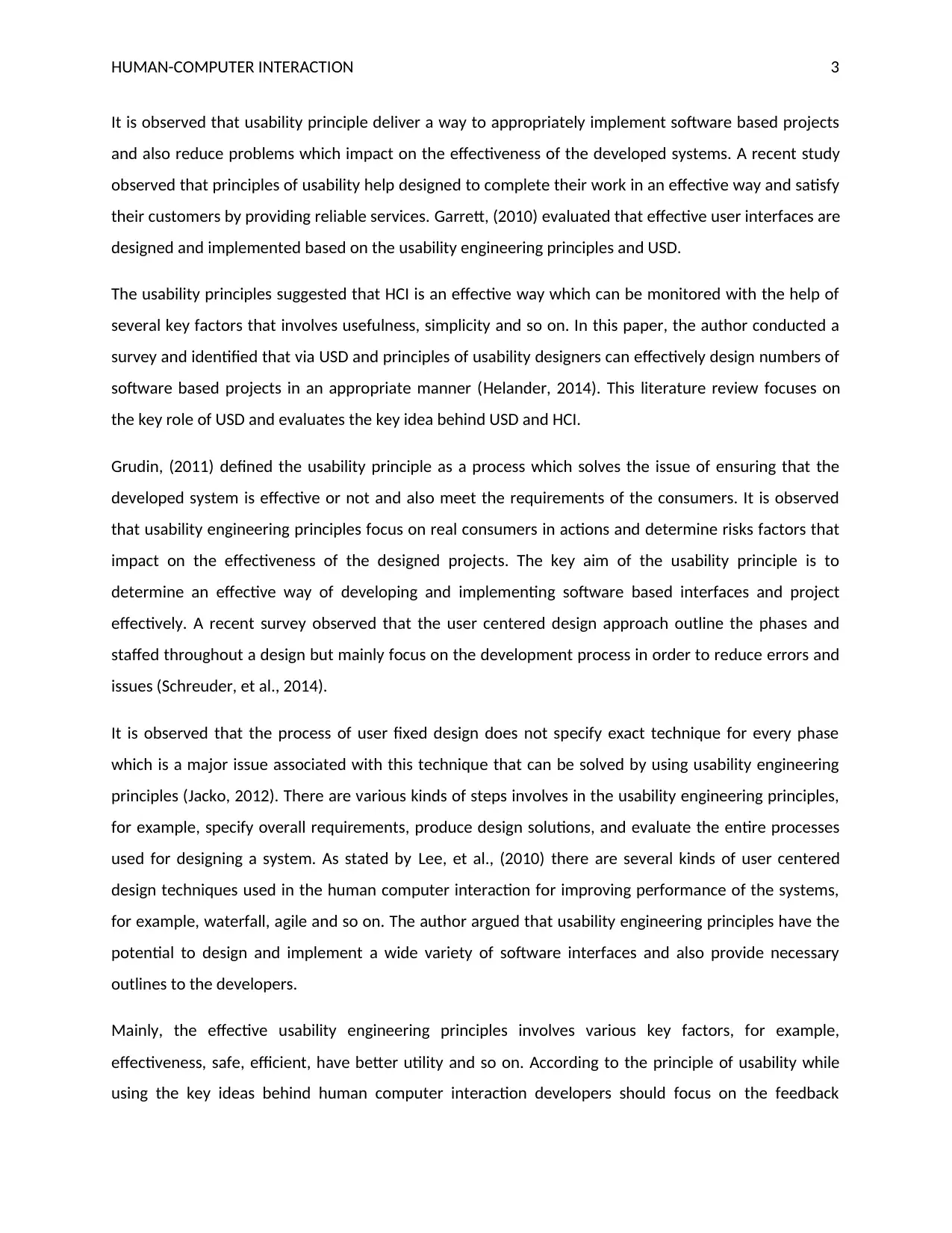
HUMAN-COMPUTER INTERACTION 3
It is observed that usability principle deliver a way to appropriately implement software based projects
and also reduce problems which impact on the effectiveness of the developed systems. A recent study
observed that principles of usability help designed to complete their work in an effective way and satisfy
their customers by providing reliable services. Garrett, (2010) evaluated that effective user interfaces are
designed and implemented based on the usability engineering principles and USD.
The usability principles suggested that HCI is an effective way which can be monitored with the help of
several key factors that involves usefulness, simplicity and so on. In this paper, the author conducted a
survey and identified that via USD and principles of usability designers can effectively design numbers of
software based projects in an appropriate manner (Helander, 2014). This literature review focuses on
the key role of USD and evaluates the key idea behind USD and HCI.
Grudin, (2011) defined the usability principle as a process which solves the issue of ensuring that the
developed system is effective or not and also meet the requirements of the consumers. It is observed
that usability engineering principles focus on real consumers in actions and determine risks factors that
impact on the effectiveness of the designed projects. The key aim of the usability principle is to
determine an effective way of developing and implementing software based interfaces and project
effectively. A recent survey observed that the user centered design approach outline the phases and
staffed throughout a design but mainly focus on the development process in order to reduce errors and
issues (Schreuder, et al., 2014).
It is observed that the process of user fixed design does not specify exact technique for every phase
which is a major issue associated with this technique that can be solved by using usability engineering
principles (Jacko, 2012). There are various kinds of steps involves in the usability engineering principles,
for example, specify overall requirements, produce design solutions, and evaluate the entire processes
used for designing a system. As stated by Lee, et al., (2010) there are several kinds of user centered
design techniques used in the human computer interaction for improving performance of the systems,
for example, waterfall, agile and so on. The author argued that usability engineering principles have the
potential to design and implement a wide variety of software interfaces and also provide necessary
outlines to the developers.
Mainly, the effective usability engineering principles involves various key factors, for example,
effectiveness, safe, efficient, have better utility and so on. According to the principle of usability while
using the key ideas behind human computer interaction developers should focus on the feedback
It is observed that usability principle deliver a way to appropriately implement software based projects
and also reduce problems which impact on the effectiveness of the developed systems. A recent study
observed that principles of usability help designed to complete their work in an effective way and satisfy
their customers by providing reliable services. Garrett, (2010) evaluated that effective user interfaces are
designed and implemented based on the usability engineering principles and USD.
The usability principles suggested that HCI is an effective way which can be monitored with the help of
several key factors that involves usefulness, simplicity and so on. In this paper, the author conducted a
survey and identified that via USD and principles of usability designers can effectively design numbers of
software based projects in an appropriate manner (Helander, 2014). This literature review focuses on
the key role of USD and evaluates the key idea behind USD and HCI.
Grudin, (2011) defined the usability principle as a process which solves the issue of ensuring that the
developed system is effective or not and also meet the requirements of the consumers. It is observed
that usability engineering principles focus on real consumers in actions and determine risks factors that
impact on the effectiveness of the designed projects. The key aim of the usability principle is to
determine an effective way of developing and implementing software based interfaces and project
effectively. A recent survey observed that the user centered design approach outline the phases and
staffed throughout a design but mainly focus on the development process in order to reduce errors and
issues (Schreuder, et al., 2014).
It is observed that the process of user fixed design does not specify exact technique for every phase
which is a major issue associated with this technique that can be solved by using usability engineering
principles (Jacko, 2012). There are various kinds of steps involves in the usability engineering principles,
for example, specify overall requirements, produce design solutions, and evaluate the entire processes
used for designing a system. As stated by Lee, et al., (2010) there are several kinds of user centered
design techniques used in the human computer interaction for improving performance of the systems,
for example, waterfall, agile and so on. The author argued that usability engineering principles have the
potential to design and implement a wide variety of software interfaces and also provide necessary
outlines to the developers.
Mainly, the effective usability engineering principles involves various key factors, for example,
effectiveness, safe, efficient, have better utility and so on. According to the principle of usability while
using the key ideas behind human computer interaction developers should focus on the feedback
Paraphrase This Document
Need a fresh take? Get an instant paraphrase of this document with our AI Paraphraser
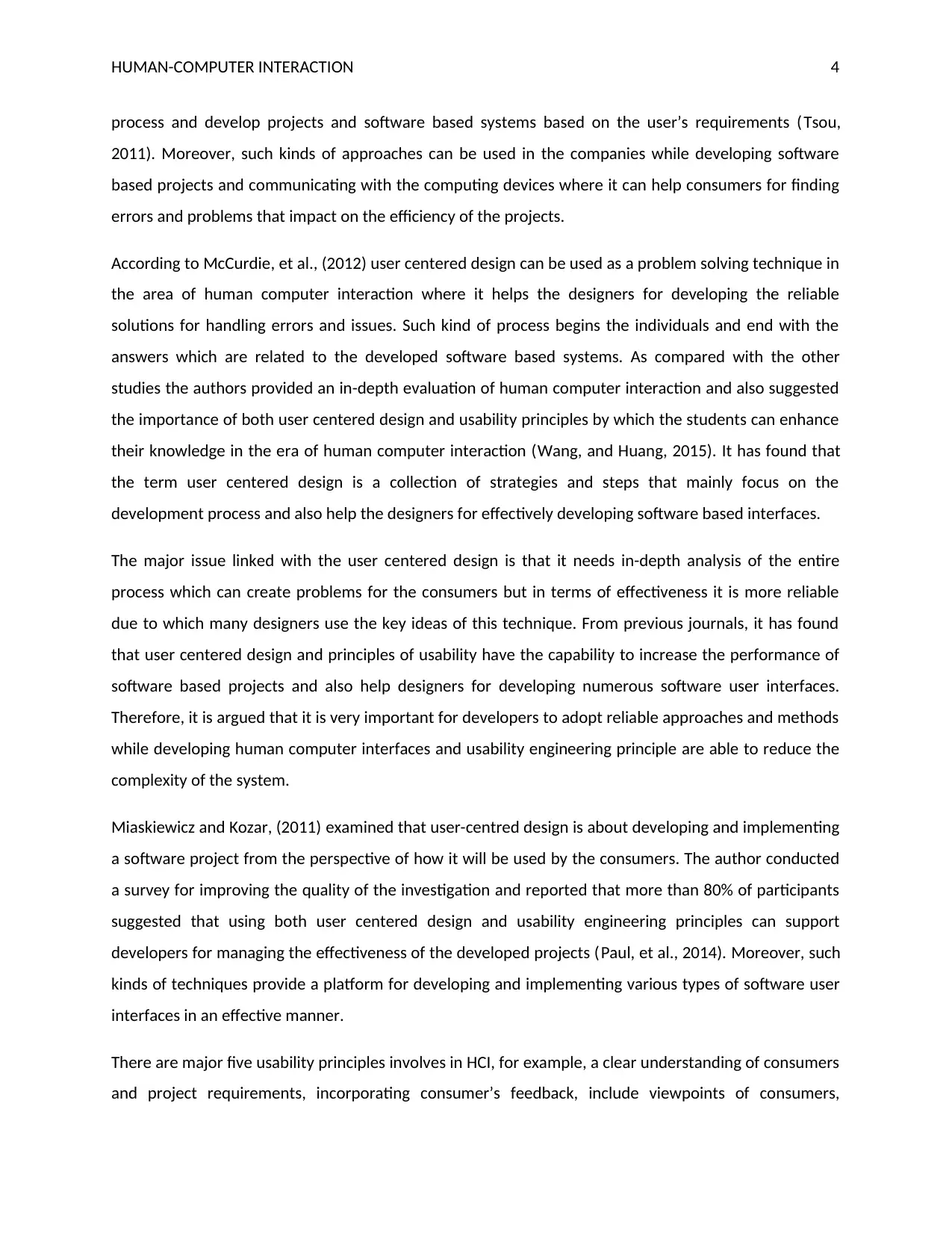
HUMAN-COMPUTER INTERACTION 4
process and develop projects and software based systems based on the user’s requirements ( Tsou,
2011). Moreover, such kinds of approaches can be used in the companies while developing software
based projects and communicating with the computing devices where it can help consumers for finding
errors and problems that impact on the efficiency of the projects.
According to McCurdie, et al., (2012) user centered design can be used as a problem solving technique in
the area of human computer interaction where it helps the designers for developing the reliable
solutions for handling errors and issues. Such kind of process begins the individuals and end with the
answers which are related to the developed software based systems. As compared with the other
studies the authors provided an in-depth evaluation of human computer interaction and also suggested
the importance of both user centered design and usability principles by which the students can enhance
their knowledge in the era of human computer interaction (Wang, and Huang, 2015). It has found that
the term user centered design is a collection of strategies and steps that mainly focus on the
development process and also help the designers for effectively developing software based interfaces.
The major issue linked with the user centered design is that it needs in-depth analysis of the entire
process which can create problems for the consumers but in terms of effectiveness it is more reliable
due to which many designers use the key ideas of this technique. From previous journals, it has found
that user centered design and principles of usability have the capability to increase the performance of
software based projects and also help designers for developing numerous software user interfaces.
Therefore, it is argued that it is very important for developers to adopt reliable approaches and methods
while developing human computer interfaces and usability engineering principle are able to reduce the
complexity of the system.
Miaskiewicz and Kozar, (2011) examined that user-centred design is about developing and implementing
a software project from the perspective of how it will be used by the consumers. The author conducted
a survey for improving the quality of the investigation and reported that more than 80% of participants
suggested that using both user centered design and usability engineering principles can support
developers for managing the effectiveness of the developed projects (Paul, et al., 2014). Moreover, such
kinds of techniques provide a platform for developing and implementing various types of software user
interfaces in an effective manner.
There are major five usability principles involves in HCI, for example, a clear understanding of consumers
and project requirements, incorporating consumer’s feedback, include viewpoints of consumers,
process and develop projects and software based systems based on the user’s requirements ( Tsou,
2011). Moreover, such kinds of approaches can be used in the companies while developing software
based projects and communicating with the computing devices where it can help consumers for finding
errors and problems that impact on the efficiency of the projects.
According to McCurdie, et al., (2012) user centered design can be used as a problem solving technique in
the area of human computer interaction where it helps the designers for developing the reliable
solutions for handling errors and issues. Such kind of process begins the individuals and end with the
answers which are related to the developed software based systems. As compared with the other
studies the authors provided an in-depth evaluation of human computer interaction and also suggested
the importance of both user centered design and usability principles by which the students can enhance
their knowledge in the era of human computer interaction (Wang, and Huang, 2015). It has found that
the term user centered design is a collection of strategies and steps that mainly focus on the
development process and also help the designers for effectively developing software based interfaces.
The major issue linked with the user centered design is that it needs in-depth analysis of the entire
process which can create problems for the consumers but in terms of effectiveness it is more reliable
due to which many designers use the key ideas of this technique. From previous journals, it has found
that user centered design and principles of usability have the capability to increase the performance of
software based projects and also help designers for developing numerous software user interfaces.
Therefore, it is argued that it is very important for developers to adopt reliable approaches and methods
while developing human computer interfaces and usability engineering principle are able to reduce the
complexity of the system.
Miaskiewicz and Kozar, (2011) examined that user-centred design is about developing and implementing
a software project from the perspective of how it will be used by the consumers. The author conducted
a survey for improving the quality of the investigation and reported that more than 80% of participants
suggested that using both user centered design and usability engineering principles can support
developers for managing the effectiveness of the developed projects (Paul, et al., 2014). Moreover, such
kinds of techniques provide a platform for developing and implementing various types of software user
interfaces in an effective manner.
There are major five usability principles involves in HCI, for example, a clear understanding of consumers
and project requirements, incorporating consumer’s feedback, include viewpoints of consumers,
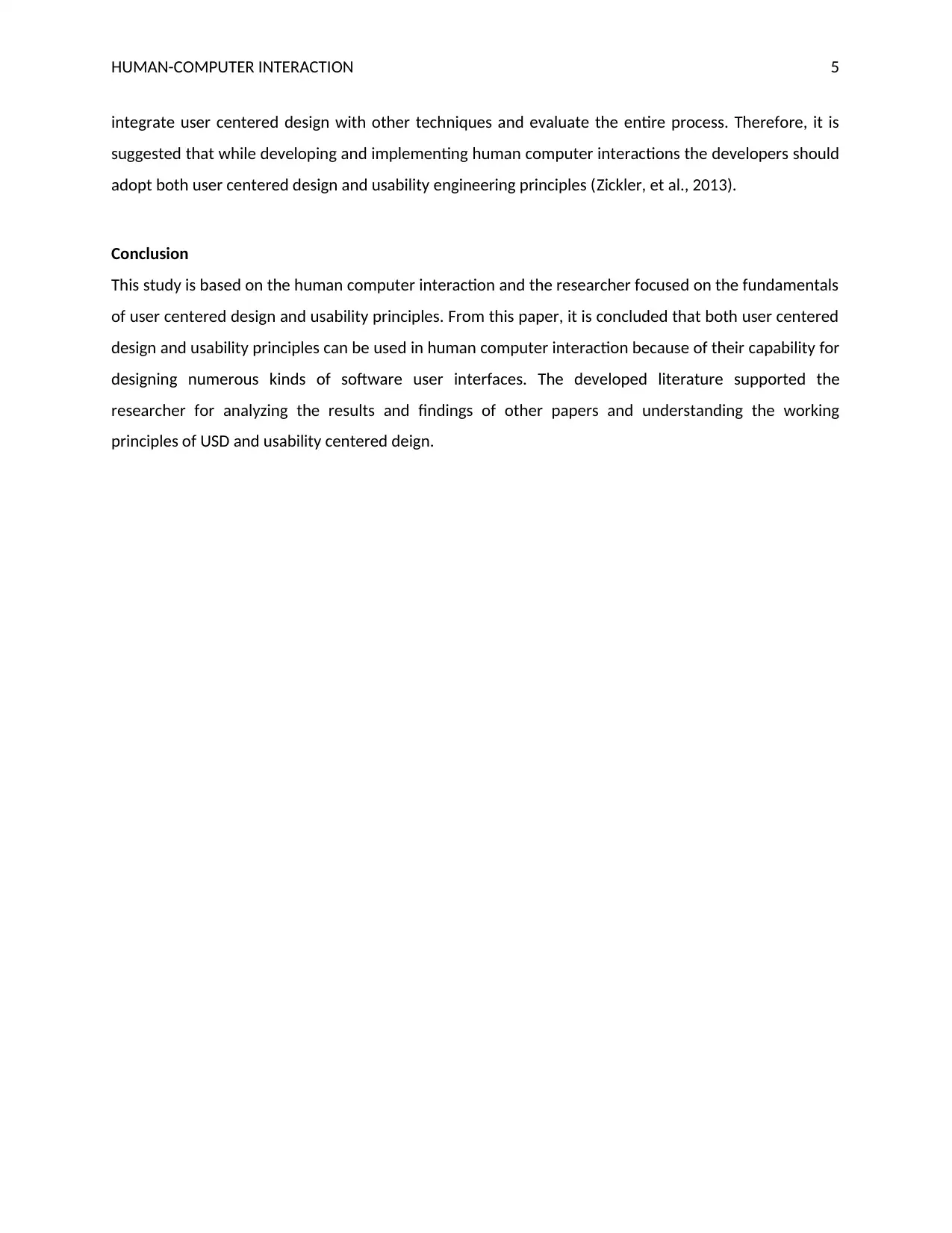
HUMAN-COMPUTER INTERACTION 5
integrate user centered design with other techniques and evaluate the entire process. Therefore, it is
suggested that while developing and implementing human computer interactions the developers should
adopt both user centered design and usability engineering principles (Zickler, et al., 2013).
Conclusion
This study is based on the human computer interaction and the researcher focused on the fundamentals
of user centered design and usability principles. From this paper, it is concluded that both user centered
design and usability principles can be used in human computer interaction because of their capability for
designing numerous kinds of software user interfaces. The developed literature supported the
researcher for analyzing the results and findings of other papers and understanding the working
principles of USD and usability centered deign.
integrate user centered design with other techniques and evaluate the entire process. Therefore, it is
suggested that while developing and implementing human computer interactions the developers should
adopt both user centered design and usability engineering principles (Zickler, et al., 2013).
Conclusion
This study is based on the human computer interaction and the researcher focused on the fundamentals
of user centered design and usability principles. From this paper, it is concluded that both user centered
design and usability principles can be used in human computer interaction because of their capability for
designing numerous kinds of software user interfaces. The developed literature supported the
researcher for analyzing the results and findings of other papers and understanding the working
principles of USD and usability centered deign.
⊘ This is a preview!⊘
Do you want full access?
Subscribe today to unlock all pages.

Trusted by 1+ million students worldwide
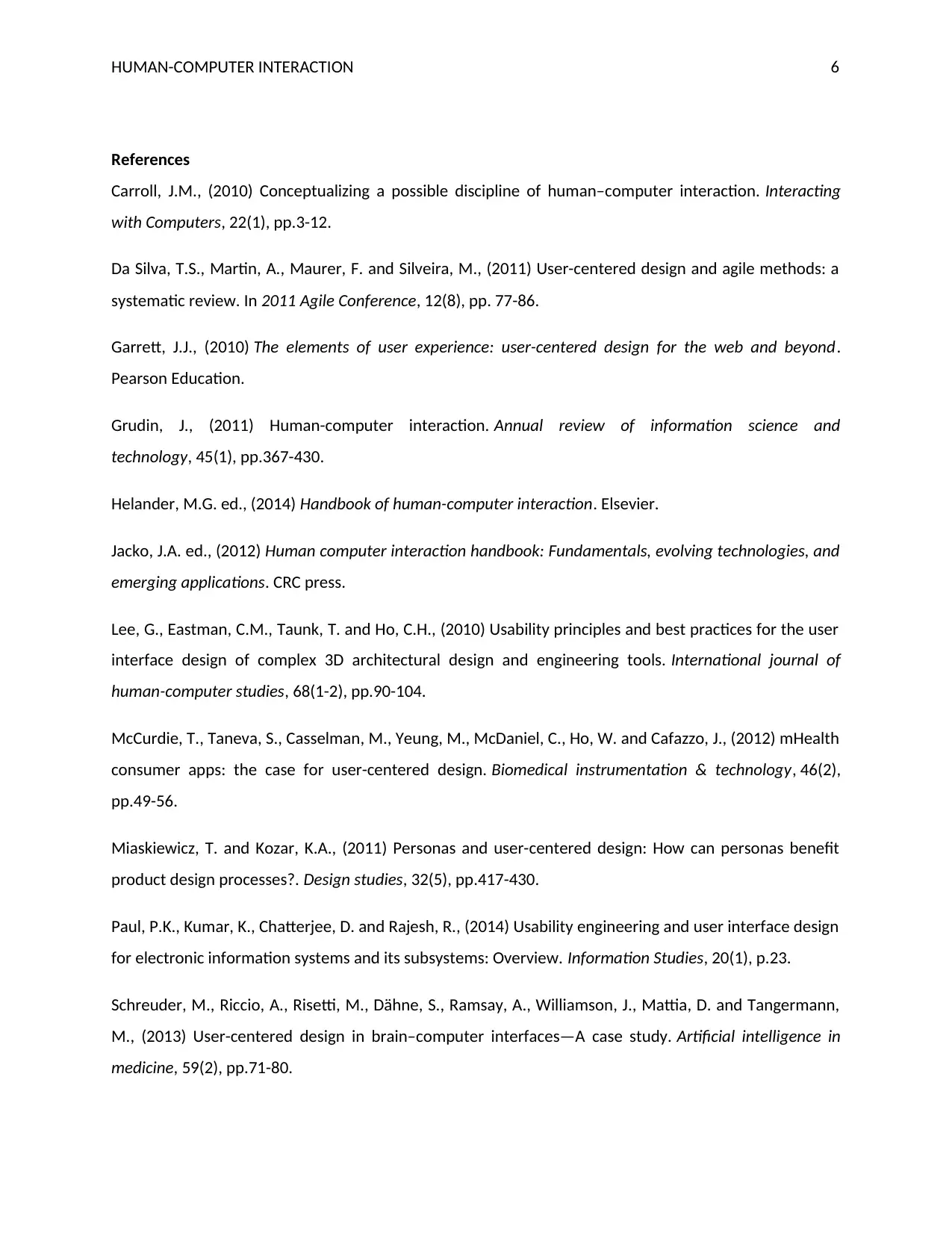
HUMAN-COMPUTER INTERACTION 6
References
Carroll, J.M., (2010) Conceptualizing a possible discipline of human–computer interaction. Interacting
with Computers, 22(1), pp.3-12.
Da Silva, T.S., Martin, A., Maurer, F. and Silveira, M., (2011) User-centered design and agile methods: a
systematic review. In 2011 Agile Conference, 12(8), pp. 77-86.
Garrett, J.J., (2010) The elements of user experience: user-centered design for the web and beyond.
Pearson Education.
Grudin, J., (2011) Human-computer interaction. Annual review of information science and
technology, 45(1), pp.367-430.
Helander, M.G. ed., (2014) Handbook of human-computer interaction. Elsevier.
Jacko, J.A. ed., (2012) Human computer interaction handbook: Fundamentals, evolving technologies, and
emerging applications. CRC press.
Lee, G., Eastman, C.M., Taunk, T. and Ho, C.H., (2010) Usability principles and best practices for the user
interface design of complex 3D architectural design and engineering tools. International journal of
human-computer studies, 68(1-2), pp.90-104.
McCurdie, T., Taneva, S., Casselman, M., Yeung, M., McDaniel, C., Ho, W. and Cafazzo, J., (2012) mHealth
consumer apps: the case for user-centered design. Biomedical instrumentation & technology, 46(2),
pp.49-56.
Miaskiewicz, T. and Kozar, K.A., (2011) Personas and user-centered design: How can personas benefit
product design processes?. Design studies, 32(5), pp.417-430.
Paul, P.K., Kumar, K., Chatterjee, D. and Rajesh, R., (2014) Usability engineering and user interface design
for electronic information systems and its subsystems: Overview. Information Studies, 20(1), p.23.
Schreuder, M., Riccio, A., Risetti, M., Dähne, S., Ramsay, A., Williamson, J., Mattia, D. and Tangermann,
M., (2013) User-centered design in brain–computer interfaces—A case study. Artificial intelligence in
medicine, 59(2), pp.71-80.
References
Carroll, J.M., (2010) Conceptualizing a possible discipline of human–computer interaction. Interacting
with Computers, 22(1), pp.3-12.
Da Silva, T.S., Martin, A., Maurer, F. and Silveira, M., (2011) User-centered design and agile methods: a
systematic review. In 2011 Agile Conference, 12(8), pp. 77-86.
Garrett, J.J., (2010) The elements of user experience: user-centered design for the web and beyond.
Pearson Education.
Grudin, J., (2011) Human-computer interaction. Annual review of information science and
technology, 45(1), pp.367-430.
Helander, M.G. ed., (2014) Handbook of human-computer interaction. Elsevier.
Jacko, J.A. ed., (2012) Human computer interaction handbook: Fundamentals, evolving technologies, and
emerging applications. CRC press.
Lee, G., Eastman, C.M., Taunk, T. and Ho, C.H., (2010) Usability principles and best practices for the user
interface design of complex 3D architectural design and engineering tools. International journal of
human-computer studies, 68(1-2), pp.90-104.
McCurdie, T., Taneva, S., Casselman, M., Yeung, M., McDaniel, C., Ho, W. and Cafazzo, J., (2012) mHealth
consumer apps: the case for user-centered design. Biomedical instrumentation & technology, 46(2),
pp.49-56.
Miaskiewicz, T. and Kozar, K.A., (2011) Personas and user-centered design: How can personas benefit
product design processes?. Design studies, 32(5), pp.417-430.
Paul, P.K., Kumar, K., Chatterjee, D. and Rajesh, R., (2014) Usability engineering and user interface design
for electronic information systems and its subsystems: Overview. Information Studies, 20(1), p.23.
Schreuder, M., Riccio, A., Risetti, M., Dähne, S., Ramsay, A., Williamson, J., Mattia, D. and Tangermann,
M., (2013) User-centered design in brain–computer interfaces—A case study. Artificial intelligence in
medicine, 59(2), pp.71-80.
Paraphrase This Document
Need a fresh take? Get an instant paraphrase of this document with our AI Paraphraser
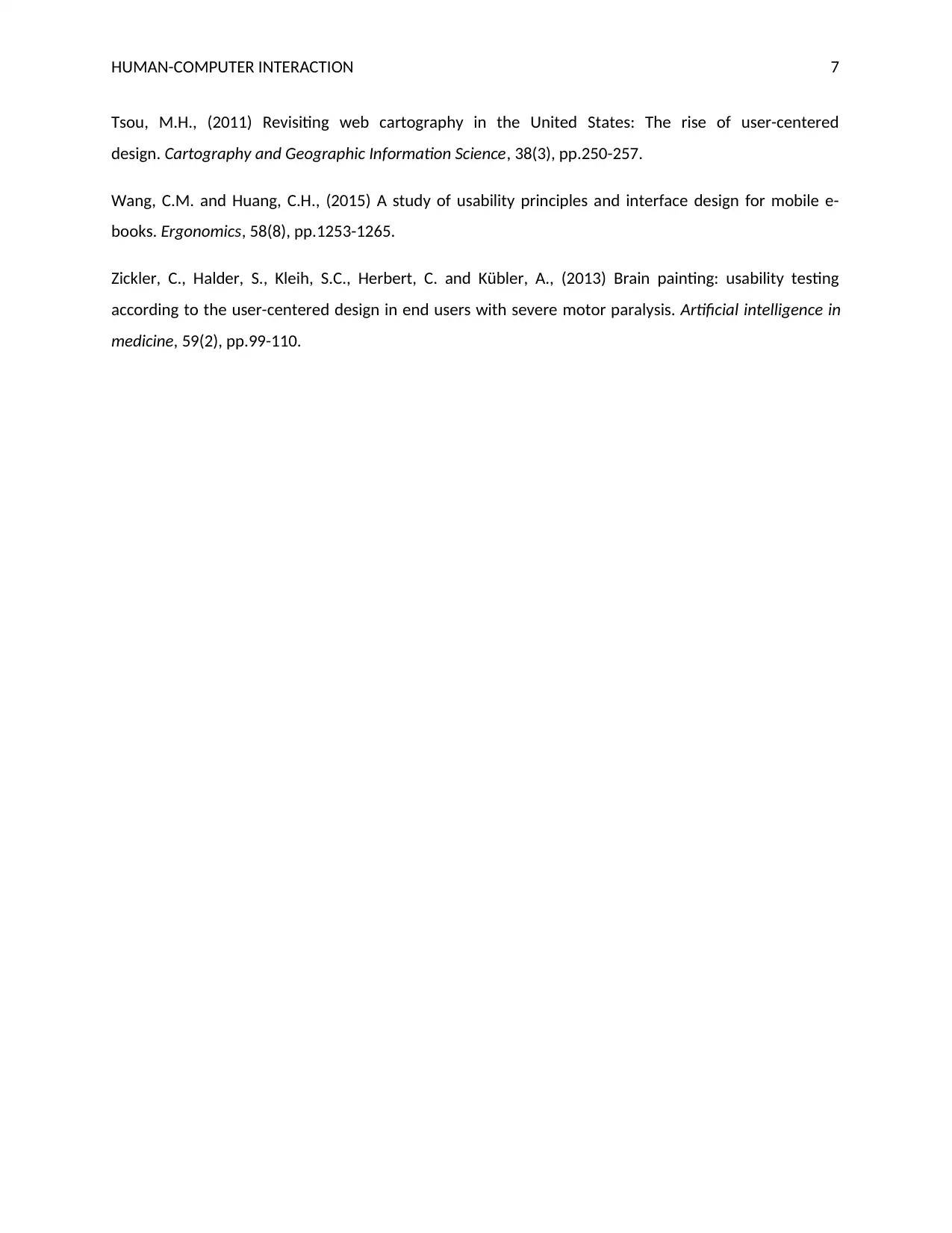
HUMAN-COMPUTER INTERACTION 7
Tsou, M.H., (2011) Revisiting web cartography in the United States: The rise of user-centered
design. Cartography and Geographic Information Science, 38(3), pp.250-257.
Wang, C.M. and Huang, C.H., (2015) A study of usability principles and interface design for mobile e-
books. Ergonomics, 58(8), pp.1253-1265.
Zickler, C., Halder, S., Kleih, S.C., Herbert, C. and Kübler, A., (2013) Brain painting: usability testing
according to the user-centered design in end users with severe motor paralysis. Artificial intelligence in
medicine, 59(2), pp.99-110.
Tsou, M.H., (2011) Revisiting web cartography in the United States: The rise of user-centered
design. Cartography and Geographic Information Science, 38(3), pp.250-257.
Wang, C.M. and Huang, C.H., (2015) A study of usability principles and interface design for mobile e-
books. Ergonomics, 58(8), pp.1253-1265.
Zickler, C., Halder, S., Kleih, S.C., Herbert, C. and Kübler, A., (2013) Brain painting: usability testing
according to the user-centered design in end users with severe motor paralysis. Artificial intelligence in
medicine, 59(2), pp.99-110.
1 out of 8
Related Documents
Your All-in-One AI-Powered Toolkit for Academic Success.
+13062052269
info@desklib.com
Available 24*7 on WhatsApp / Email
![[object Object]](/_next/static/media/star-bottom.7253800d.svg)
Unlock your academic potential
Copyright © 2020–2025 A2Z Services. All Rights Reserved. Developed and managed by ZUCOL.





